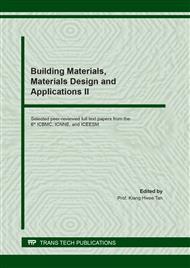[1]
Zhang H, Baeyens J, Cáceres G, et al. Thermal energy storage: Recent developments and practical aspects. Progress in Energy & Combustion Science 2016; 53:1-40.
DOI: 10.1016/j.pecs.2015.10.003
Google Scholar
[2]
Medrano M, Yilmaz M O, Nogues M, et al. Experimental evaluation of commercial heat exchangers for use as PCM thermal storage systems. Applied Energy 2009;86(10):2047-2055.
DOI: 10.1016/j.apenergy.2009.01.014
Google Scholar
[3]
Agyenim F, Eames P, Smyth M. A comparison of heat transfer enhancement in a medium temperature thermal energy storage heat exchanger using fins. Solar Energy 2009;83(9): 1509-1520.
DOI: 10.1016/j.solener.2009.04.007
Google Scholar
[4]
Sun Y, Wang S, Xiao F, Gao D. Peak load shifting control using different cold thermal energy storage facilities in commercial buildings: a review. Energy Convers Manage 2013;71:101–114.
DOI: 10.1016/j.enconman.2013.03.026
Google Scholar
[5]
Wang J, Zhong H, Ma Z, Xia Q, Kang C. Review and prospect of integrated demand response in the multi-energy system. Appl Energy 2017;202:772–782.
DOI: 10.1016/j.apenergy.2017.05.150
Google Scholar
[6]
Kalnæs SE, Jelle BP. Phase change materials and products for building applications: a state-of-the-art review and future research opportunities. Energy Build 2015;94:150–176.
DOI: 10.1016/j.enbuild.2015.02.023
Google Scholar
[7]
Khan Z, Khan Z, Ghafoor A. A review of performance enhancement of PCM based latent heat storage system within the context of materials, thermal stability and compatibility. Energy Convers Manage 2016;115:132–158.
DOI: 10.1016/j.enconman.2016.02.045
Google Scholar
[8]
Abdulateef AM, Mat S, Abdulateef J, Sopian K, Al-Abidi AA. Geometric and design parameters of fifins employed for enhancing thermal energy storage systems: a review. Renew Sustain Energy Rev 2018;82:1620–1635.
DOI: 10.1016/j.rser.2017.07.009
Google Scholar
[9]
ZHANG P, XIAO X, MA Z W. A review of the composite phase change materials: Fabrication, characterization, mathematical modeling and application to performance enhancement. Applied Energy 2016;165:472-510.
DOI: 10.1016/j.apenergy.2015.12.043
Google Scholar
[10]
KENISARIN M, MAHKAMOV K. Salt hydrates as latent heat storage materials: Thermophysical properties and costs. SolarEnergy Materials & Solar Cells 2016;145: 255-286.
DOI: 10.1016/j.solmat.2015.10.029
Google Scholar
[11]
Tabassum T, Hasan M, Begum L. Transient melting of an impure paraffin wax in a double-pipe heat exchanger: Effect of forced convective flow of the heat transfer fluid. Solar Energy 2018; 159:197-211.
DOI: 10.1016/j.solener.2017.10.082
Google Scholar


